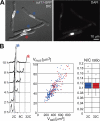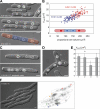Nuclear size control in fission yeast
- PMID: 17998401
- PMCID: PMC2080919
- DOI: 10.1083/jcb.200708054
Nuclear size control in fission yeast
Abstract
A long-standing biological question is how a eukaryotic cell controls the size of its nucleus. We report here that in fission yeast, nuclear size is proportional to cell size over a 35-fold range, and use mutants to show that a 16-fold change in nuclear DNA content does not influence the relative size of the nucleus. Multi-nucleated cells with unevenly distributed nuclei reveal that nuclei surrounded by a greater volume of cytoplasm grow more rapidly. During interphase of the cell cycle nuclear growth is proportional to cell growth, and during mitosis there is a rapid expansion of the nuclear envelope. When the nuclear/cell (N/C) volume ratio is increased by centrifugation or genetic manipulation, nuclear growth is arrested while the cell continues to grow; in contrast, low N/C ratios are rapidly corrected by nuclear growth. We propose that there is a general cellular control linking nuclear growth to cell size.
Figures





Comment in
-
The size-wise nucleus: nuclear volume control in eukaryotes.J Cell Biol. 2007 Nov 19;179(4):583-4. doi: 10.1083/jcb.200710156. Epub 2007 Nov 12. J Cell Biol. 2007. PMID: 17998404 Free PMC article.
Similar articles
-
The size-wise nucleus: nuclear volume control in eukaryotes.J Cell Biol. 2007 Nov 19;179(4):583-4. doi: 10.1083/jcb.200710156. Epub 2007 Nov 12. J Cell Biol. 2007. PMID: 17998404 Free PMC article.
-
The fission yeast Schizosaccharomyces pombe has two importin-alpha proteins, Imp1p and Cut15p, which have common and unique functions in nucleocytoplasmic transport and cell cycle progression.Genetics. 2005 Sep;171(1):7-21. doi: 10.1534/genetics.105.042598. Epub 2005 Jun 3. Genetics. 2005. PMID: 15937127 Free PMC article.
-
Nuclear compartmentalization is abolished during fission yeast meiosis.Curr Biol. 2010 Nov 9;20(21):1913-8. doi: 10.1016/j.cub.2010.09.004. Epub 2010 Oct 21. Curr Biol. 2010. PMID: 20970334
-
How do fission yeast cells grow and connect growth to the mitotic cycle?Curr Genet. 2017 May;63(2):165-173. doi: 10.1007/s00294-016-0632-0. Epub 2016 Jul 27. Curr Genet. 2017. PMID: 27465359 Review.
-
Control of cellular organization and its coordination with the cell cycle.Biosci Biotechnol Biochem. 2020 May;84(5):869-875. doi: 10.1080/09168451.2020.1717926. Epub 2020 Jan 27. Biosci Biotechnol Biochem. 2020. PMID: 31987003 Review.
Cited by
-
Theory on the dynamics of feedforward loops in the transcription factor networks.PLoS One. 2012;7(7):e41027. doi: 10.1371/journal.pone.0041027. Epub 2012 Jul 20. PLoS One. 2012. PMID: 22911735 Free PMC article.
-
Nuclear envelope insertion of spindle pole bodies and nuclear pore complexes.Nucleus. 2012 May-Jun;3(3):226-36. doi: 10.4161/nucl.20148. Epub 2012 May 1. Nucleus. 2012. PMID: 22572959 Free PMC article. Review.
-
A homeostatic mechanism rapidly corrects aberrant nucleocytoplasmic ratios maintaining nuclear size in fission yeast.J Cell Sci. 2019 Nov 14;132(22):jcs235911. doi: 10.1242/jcs.235911. J Cell Sci. 2019. PMID: 31649142 Free PMC article.
-
Sizing up the nucleus: nuclear shape, size and nuclear-envelope assembly.J Cell Sci. 2009 May 15;122(Pt 10):1477-86. doi: 10.1242/jcs.037333. J Cell Sci. 2009. PMID: 19420234 Free PMC article. Review.
-
Explaining lengths and shapes of yeast by scaling arguments.PLoS One. 2009 Jul 10;4(7):e6205. doi: 10.1371/journal.pone.0006205. PLoS One. 2009. PMID: 19593452 Free PMC article.
References
-
- Bai, S.W., J. Rouquette, M. Umeda, W. Faigle, D. Loew, S. Sazer, and V. Doye. 2004. The fission yeast Nup107-120 complex functionally interacts with the small GTPase Ran/Spi1 and is required for mRNA export, nuclear pore distribution, and proper cell division. Mol. Cell. Biol. 24:6379–6392. - PMC - PubMed
-
- Boveri, T. 1905. Zellenstudien V. Über die Abhängigkeit der Kerngrösse und Zellenzahl bei Seeigellarven von der Chromosomenzahl der Ausganszellen. Jena. Z. Naturw. 39:445–524.
-
- Brandt, A., F. Papagiannouli, N. Wagner, M. Wilsch-Brauninger, M. Braun, E.E. Furlong, S. Loserth, C. Wenzl, F. Pilot, N. Vogt, et al. 2006. Developmental control of nuclear size and shape by Kugelkern and Kurzkern. Curr. Biol. 16:543–552. - PubMed
-
- Cavalier-Smith, T. 1982. Skeletal DNA and the evolution of genome size. Annu. Rev. Biophys. Bioeng. 11:273–302. - PubMed
Publication types
MeSH terms
Substances
LinkOut - more resources
Full Text Sources
Other Literature Sources
Molecular Biology Databases

